Overview
Depending on the treatment and treatment-related side effects resulting from the management of head and neck cancer, a patient’s ability to speak, eat, and swallow may be affected. The speech-language pathologist (SLP) will play a vital role in assessing, treating, and guiding the patient and their family through the treatment and recovery journey.
Swallowing Function
There are three types of swallow exams that help clinicians assess a patient’s ability to swallow and to develop strategies and techniques to maximize the safety and efficiency of the swallow: Clinical Swallowing Evaluation (CSE), Fiberoptic Endoscopic Evaluation of Swallowing (FEES), and Modified Barium Swallow Study (MBSS).
During the CSE, the SLP will do a thorough review of the medical history and obtain various measurements of a patient’s speech, voice and swallowing functioning, make diet recommendations, and provide targeted exercises as appropriate.
During the FEES exam, a SLP will pass a thin, flexible instrument called an endoscope through the nose of a patient. The clinician will then directly examine the parts of the patient’s throat involved in swallowing, speaking, and breathing while the patient swallows different consistencies of food and liquids. This exam allows for direct visualization of the presence of aspiration, which refers to the inappropriate passage of food/liquids through the vocal cords and into the airway, collection of residual food or liquids in the throat, or other potential issues with swallow function.
During a MBS study, a patient will be placed in front of a fluoroscopy or X-ray machine and asked to swallow various volumes and consistencies of food and liquids coated in barium. In doing so, the SLP will be able to observe all stages of the patient’s swallow indirectly by looking at the video of the x-ray images. This test provides valuable information regarding the presence of aspiration and therefore helps to determine if it is safe for the patient to take nutrition and/or hydration by mouth. Due to the small exposure to radiation, pregnant patients may not be suitable for this exam.
Swallowing Rehabilitation
Swallowing function can be impaired by a number of different treatments required to overcome the cancer. The more intense the therapy, the more of an impact that it will have on the patient’s ability to safely and effectively swallow.
The following treatments commonly used in head and neck cancer can impact the patient’s swallow:
- Surgery may involve the removal of structures vital to swallowing and airway protection
- Radiation impacts the ability for the throat muscles to contract effectively
- Chemotherapy can compound the effects of radiation if the two are used in combination
Additionally, patients who are unable to or choose not to swallow during therapy may suffer a loss of coordination of the swallow mechanism. This loss of coordination can result from a patient’s reliance on a G-tube for nutrition during and after therapy due to pain, lack of taste, risk of aspiration, or loss of appetite. In addition, the prolonged time required to complete a meal often leads patients to become discouraged and elect to use their G tube as the primary route of food and liquids into the body. These deficits can occur even several years after the completion of surgery, radiation therapy or chemoradiation therapy. The severity of swallowing disorders (dysphagia) may also be related to the type of treatment received, as well as the amount and location of tissue radiated or removed during surgery.
Dysphagia may occur during any of the different stages of swallowing, including the oral phase, pharyngeal phase, and esophageal phase. These three phases of swallowing occur, as their names suggest, as food or liquid passes through each of these anatomical regions: the oral cavity, pharynx, and esophagus. Since there is significant overlap of these areas in many head and neck cancers, the cause of dysphagia is often multifactorial.
Other causes of swallowing disorders include trismus (the limited opening of the jaw) and a reduced jaw range of motion (ROM). In addition to limiting the amount of food that can fit through the mouth opening, trismus affects a patient’s ability to chew their food and as a result, swallowing can become difficult. Trismus may also affect a patient’s speech. Rehabilitation can include any of the following types of exercises: swallowing maneuvers, such as effortful swallow or Mendelsohn maneuver (prolonged swallow); ROM exercises (e.g., jaw, tongue); tongue strengthening exercises; and tactile stimulation (massage).
Dysphagia Rehabilitation
The SLP will develop an individualized rehabilitative treatment plan based on the deficits and limitations appreciated during the assessment process. Rehabilitation may target labial, lingual, buccal, pharyngeal or laryngeal deficits. The exercises include passive and active range of motion, resistance exercises and exercises specifically targeting the ability to clear the bolus through the oral cavity, oropharynx and into the esophagus.
Diet Recommendations
The SLP will make recommendations on the appropriate foods and liquids a patient may take. These recommendations are based on the assessment performed to maximize safety and efficiency. Adhering to these recommendations helps to ensure caloric needs are met.
Jaw Mobilization Techniques
The SLP will provide active and passive jaw range of motion (ROM) exercises if trismus is appreciated. These exercises may also be provided prophylactically to prevent trismus from occurring during or after head and neck cancer treatment. Severe trismus may lead to difficulty with speech, eating by mouth, oral hygiene and respiration. Depending upon the severity of the impairment, a jaw motion rehabilitation tool may be recommended to provide a more sustained ROM (Therabite, Dynasplint and Oro-Stretch are some of the devices available).

Therabite
The Therabite is a handheld device that is used to improve jaw range of motion. The device is used by placing bite pads between the teeth and squeezing the lever to open the jaw to the desired opening that is established by the SLP.
It is designed to follow the natural curved pathway of the jaw when opening and closing while stretching and strengthening the surrounding musculature. Duration of the stretch will be set by the SLP, with the goal of gradually increasing jaw opening.

OraStretch
The OraStretch works similarly to the TheraBite. The patient bites down on the bite pad and uses the clamp to slowly, passively stretch the jaw to the desired opening.
A user can increase their range-of-motion by using a knob. The OraStretch is marginally lighter weight than the Therabite and more cost effective.
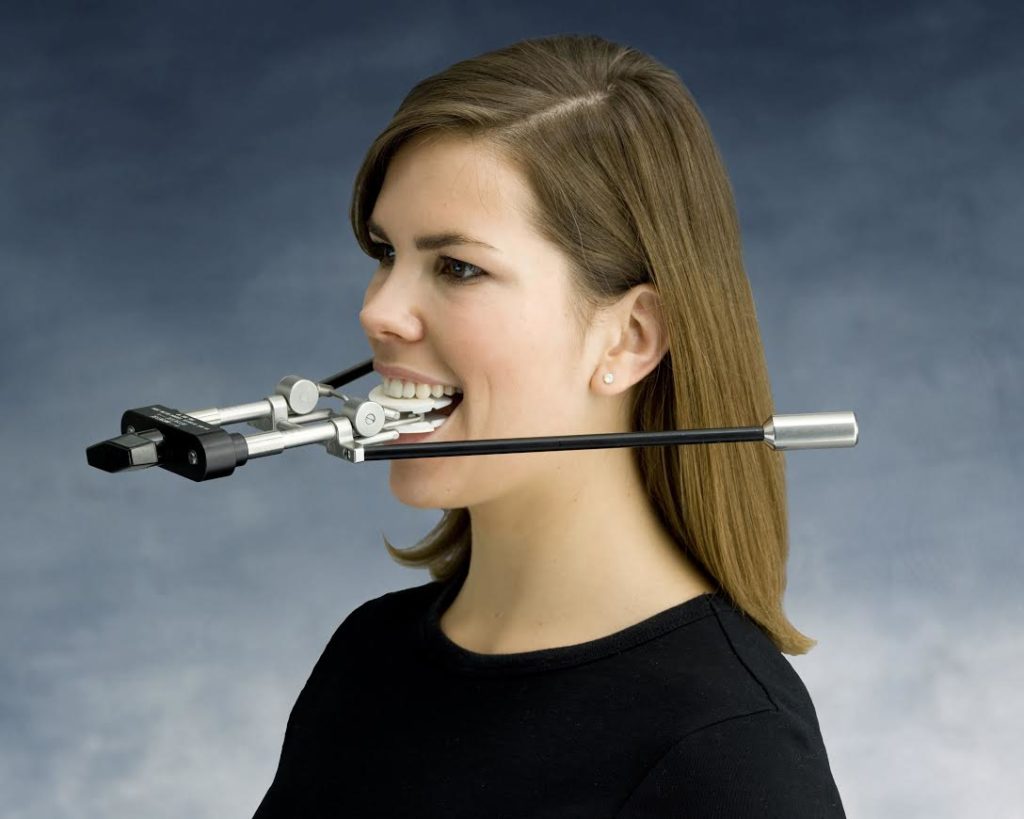
Dynasplint
The Dynasplint is a hands free device that improves jaw range of motion by using sustained spring loaded tension to maximize oral opening.
The Dynasplint is beneficial for individuals with severe trismus, as the device can be used with patients with a 7 mm maximum incisor opening. The device is inserted into the mouth in a closed position. The tension of the device is then adjusted to open the patient’s mouth to their current maximum opening without any discomfort. This position is then held for a duration that is established by the rehabilitative therapist. The tension of the device continues to be increased until maximum jaw opening is achieved. This device is generally rented for a period of time and then returned to the vendor.
Voice Rehabilitation
To produce voice, air flows through the vocal cords creating vibration. This sound is then shaped into speech using the lips, tongue, teeth, and palate. A voice impairment refers to the quality of voice a person produces (i.e. hoarse, breathy, hypernasal). Depending on the changes that occur to a patient’s anatomy post-treatment, they may be a candidate for behavioral voice rehabilitation, prosthetic devices, or surgical intervention.
Behavioral voice rehabilitation techniques typically focus on the manner in which the vocal cords come together or apart. Since voicing begins with respiration, breathing assessment and exercises may be addressed to maximize vocal quality. There are also exercises to address patients whose vocal cords close too tightly or do not close tightly enough, leading to strained or breathy voice, respectively. Vocal hygiene, or how a patient takes care of his/her voice is also a critical factor in voice rehabilitation. This usually involves discussion of hydration, diet, humidification, and volume control.
In cases of vocal fold paralysis, if behavioral interventions are not effective, surgical intervention may be indicated. Surgical treatments of this condition are designed to reposition the paralyzed vocal fold so that more effective contact can be made with the mobile vocal cord. This form of intervention can involve moving a portion of the cartilage immediately adjacent to the paralyzed vocal cord. This allows for maximum contact of the vocal folds during vibration, to optimize voice production. Alternatively, another surgical treatment of this condition involves injecting the paralyzed vocal cord with a filler of body fat, collagen, or another approved substance. This serves to increase the bulk of the paralyzed cord, again allowing for maximum contact of the vocal folds during phonation.
Speech Production
Depending on the location of the head and neck cancer, survivors may also struggle with speech impairment. Speech impairment refers to a change in the way sounds are articulated. As previously mentioned, speech sounds are produced using oral structures including the lips, tongue, teeth, and palate. Speech rehabilitation may focus on enhancing the strength/range of motion of the mobile articulators (lips and tongue) as well as their coordination. These rehabilitative measures are aimed at improving the precision of movements of the oral structures, which improve a patient’s ability to speak.
Speech Rehabilitation after Total Laryngectomy
After a total laryngectomy (removal of the voice box), patients always want to know if they will be able to speak again. The answer is most often, yes. There are a few different methods to achieve speech after a total laryngectomy. They all take training and practice to master, and a doctor and SLP will help to determine which ones work best for the patient. If they are determined to succeed, patients will be surprised at how good their voice can be by using some of these methods. The acquisition of speech is vital to a laryngectomy patient’s ability to effectively communicate and thereby to resume gainful employment and reintegration into their pretreatment social network. A consultation with an SLP should occur prior to larynx removal surgery to discuss the anatomical and physiological changes as a result of the surgery and to discuss potential alaryngeal voice options.
The three main methods of speech after a total laryngectomy are electrolarynx, esophageal speech, and tracheoesophageal puncture with prosthesis (TEP).
Electrolarynx
An electrolarynx, also called an artificial larynx, is an effective way to speak after a total laryngectomy. The electrolarynx is an external, hand held device that the patient controls by placing it against the skin of the neck or cheek. It creates vibrations, which reach the mouth and can then be modified by the structures in the mouth to allow the patient to make sounds and to articulate words. The result is a monotone voice, but one that can be well understood. This type of speech improves with practice. The disadvantage is that because this method uses an external sound source, the voice created is mechanical in nature. It usually takes the patient and their family and friends some time to get used to this sound.
Electrolarynx Usage
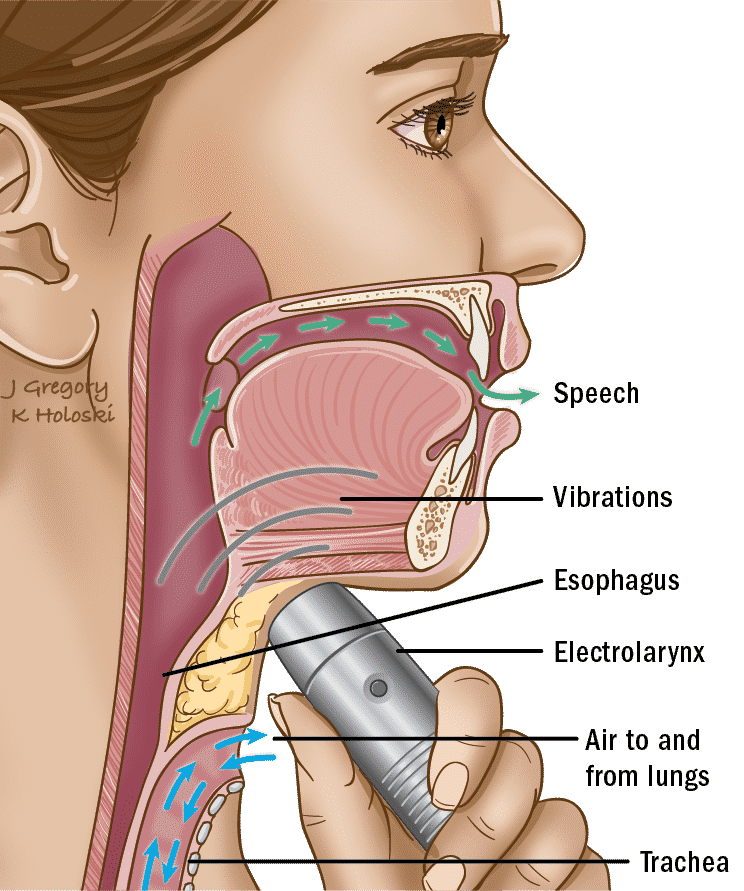
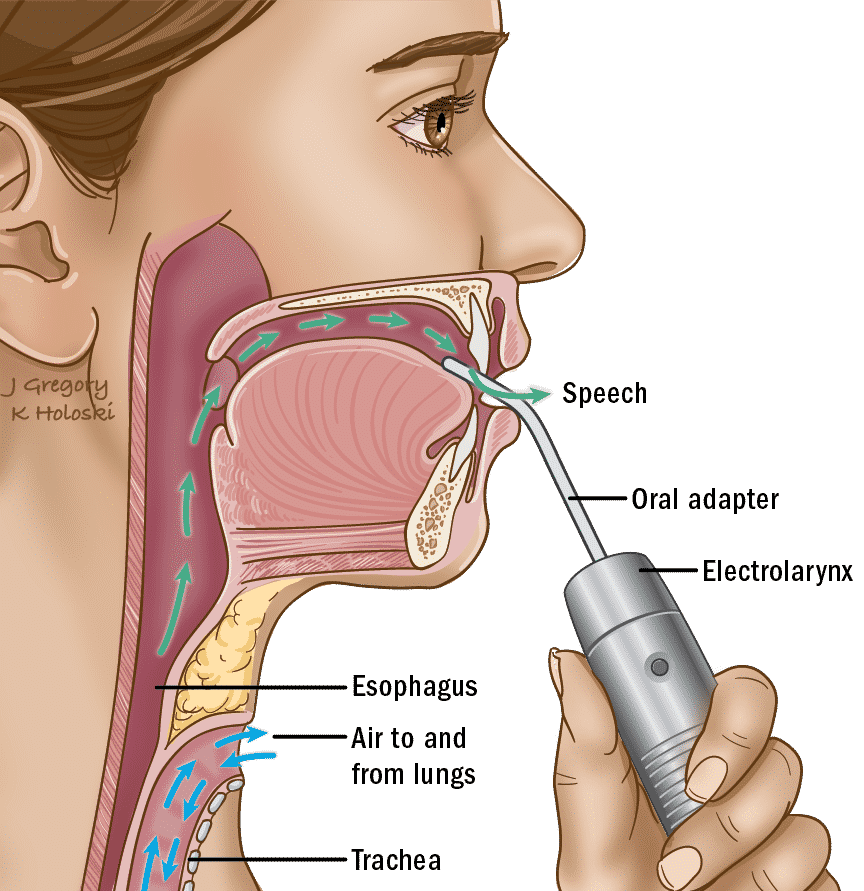
There are two methods to transmit the external sound source from the electrolarynx for voice production. The most common method involves holding the device against the skin of the neck or cheek so that the vibrations can be transmitted through the skin, as described above. The other type of electrolarynx has an attachment that looks like a straw (called an oral tube) that directs the vibrations/sound into the mouth. Regardless of which method of sound transmission is used, patients alter the sound with their lips, tongue, and mouth to effectively form speech.
Esophageal Speech
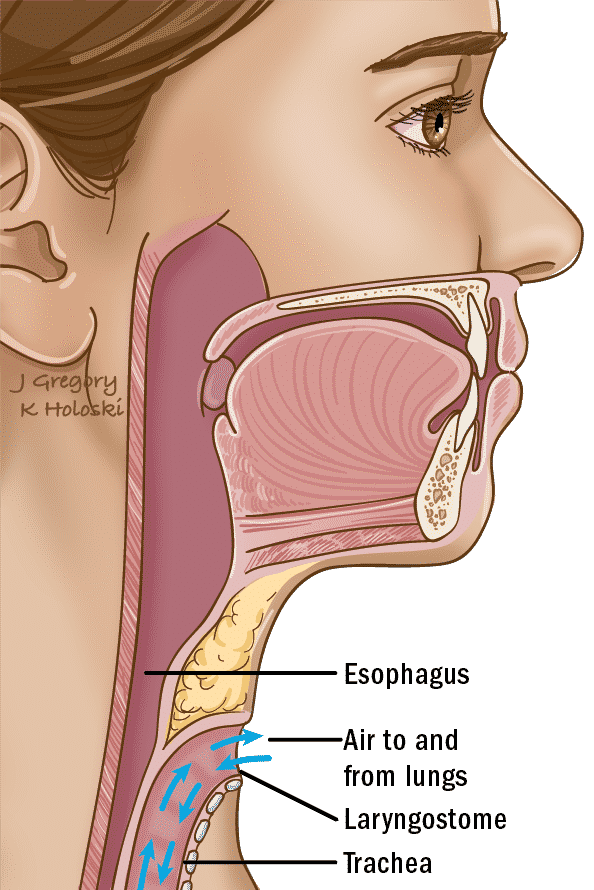
Esophageal speech is produced by swallowing air or pushing air into the esophagus and then using that column of air to generate a new voice source by essentially belching the air up from the esophagus. The air that comes up is then formed into words with the lips and the tongue. The air vibrates the surfaces of the esophagus and pharynx to create sound. The advantage of esophageal speech is that it requires no devices or procedures. The disadvantages are that it is difficult for some people to learn this technique effectively, the voice is often softer, and only short sentences can be spoken at one time.
Tracheoesophageal Puncture (TEP) with Prosthesis
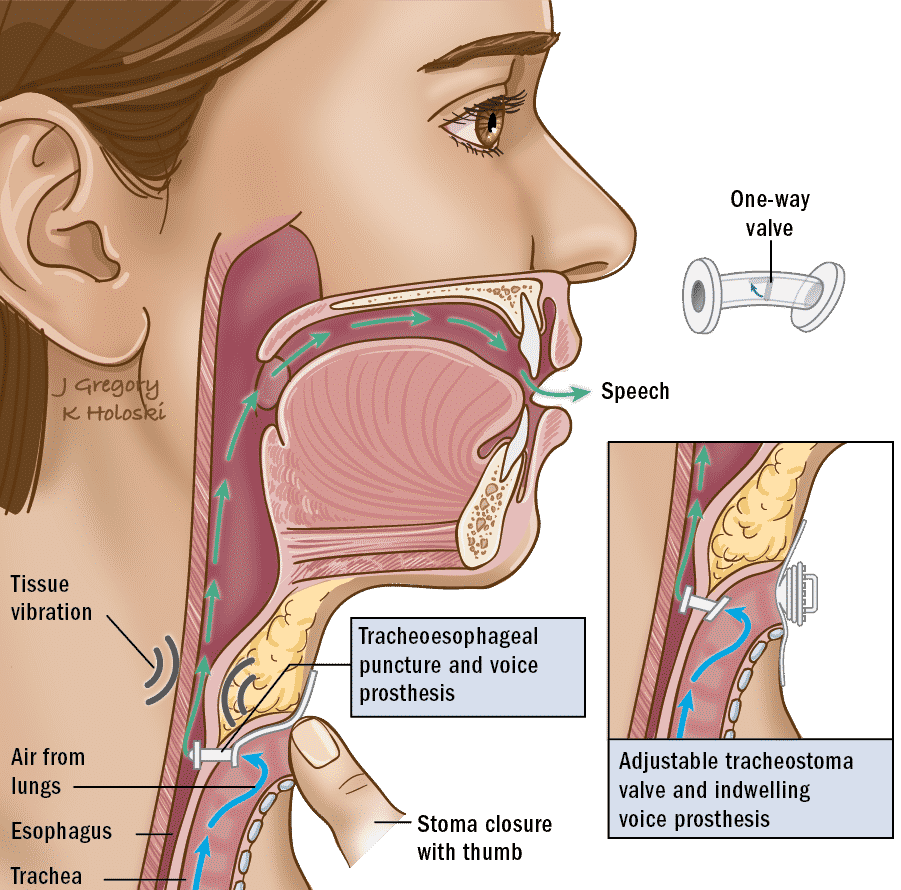
This procedure and associated device is another communication option available, that is most consistent with natural speech/voice production. The device is inserted by a surgeon in the office or in the operating room. Fitting the proper prosthesis, getting instructions on how to use it, and making any required modifications are then done by a speech pathologist in the office setting.
A primary tracheoesophageal puncture (TEP) is one that is done at the same time as the laryngectomy. A secondary TEP is done at a later date, either in the office or the operating room. Regardless of whether the TEP is done primarily or secondarily, the basic technique to create speech is the same. A small hole is made in the back wall of the trachea, near the level of where the trachea is sewn to the neck. The hole extends from the back wall of the trachea into the front wall of the esophagus. Once the puncture is created, either a temporary catheter or the prosthesis is placed through the puncture site to keep it open,. If a catheter is placed, then the prosthesis will be inserted in a week or two by a speech therapist in the office, giving the puncture tract time to mature.
The TEP prosthesis is a one-way valve that directs air from the lungs to pass through the prosthesis into the neopharynx (the newly reconstructed pharynx). The valve is closed at rest to prevent liquids and food from entering the trachea through the prosthesis.
TEP voice is created in the following way: The patient breathes in through the tracheostoma (the opening in the neck, also called the stoma) and then covers the stoma, generally with their finger, thereby directing the breath through the TEP prosthesis. The air is then directed/shunted into the neopharynx, up the throat and out the mouth. The mucosa of the reconstructed neopharynx vibrates as the air passes through, creating sound. Additionally, some patients may be candidates for hands free alaryngeal communication. The SLP and the patient will work together to master the optimal mode of communication with a TEP.
The disadvantages of a TEP prosthesis are that it can be costly, and it requires maintenance. Maintenance includes daily care of prosthesis and replacement of the TEP prosthesis every few months. Patients should plan for approximately six visits to the speech language pathologist each year for prosthesis management.
With the right amount of guidance from an experienced SLP and with practice by the patient, the speech created by a TEP device can be very clear and will improve with time.
TEP Helpful Hints
Keeping It Clean
Depending on the type, a prosthesis should come with either a brush to insert into the prosthesis or a flushing device to inject water into and through the prosthesis to clean it. For either technique, the prosthesis should be cleaned while in place in the fistula tract about twice a day. This will ensure that patients can produce clear, continuous voice.
Dealing with Leakage
If a patient notices that they are coughing when drinking or eating, this may indicate leakage: the passage of material from the esophagus into the trachea through the tract. The TEP prosthesis requires routine maintenance and replacement when leakage occurs. Leakage may occur around the prosthesis or centrally through the shaft. Leakage is concerning because any material that passes into the airway can travel to the lungs, causing infection. If leakage is suspected, it is important that the patient identify where it is coming from. A patient should remove their HME and observe themselves drinking a colored liquid while looking at their prosthesis in a mirror. If leakage is coming through the prosthesis it is considered “central leakage.” If leakage is coming around the border of the prosthesis it is called “peripheral leakage.” A scant amount of peripheral leakage is okay and is to be expected. If there is a large amount of leakage, it is important to contact a speech language pathologist to adjust the fit or position of the prosthesis. If leakage is central, it may mean that the prosthesis needs to be cleaned or replaced. A patient should first try to clean the prosthesis using a brush or flush. It is possible that food or secretion is stuck in the device, causing a malfunction. If cleaning the prosthesis does not eliminate the central leakage, the patient must contact the speech language pathologist to set up an appointment for replacement. If leakage is significant and the patient is unable to visit the SLP right away, the prosthesis can be sealed with a plug. This will prevent the patient from using the device for speech, but will allow the patient to continue eating meals and drinking safely without leaking until their prosthesis is replaced.
Fungal Infection
Naturally occurring plaque and fungal film (biofilm) tend to build up on the inner flange of the prosthesis that sits in the esophagus, and will eventually cause the valve to leak. If excessive biofilm occurs, it can lead to early leakage, necessitating frequent changes of the TEP prosthesis. Diet changes, such as reducing the amount of sugar consumed and cleaning the TEP prosthesis with white vinegar may slow the growth of the biofilm. Antifungal medication may be indicated and patients can obtain a prescription from their physician for an antifungal medicine that may slow the biofilm from developing.
If the Prosthesis Falls Out
If the TEP falls out, it is imperative that a small tube, usually a red rubber catheter, be inserted inside the puncture site immediately, before it closes up. This tube will act as a “placeholder” until the TEP prosthesis can be replaced. Placement of the catheter should be explained by the patient’s speech language pathologist when discussing other laryngectomy emergency precaution measures at the initial postoperative voice consultation. Speech will not be possible with a catheter inserted, but it will minimize the leakage and allow the patient to eat, drink, and swallow saliva safely until the TEP prosthesis is reinserted. It is also imperative that the patient identify the location of the ejected TEP. It is most likely that the TEP was ejected from the stoma (the opening in the neck). However, it is possible that the device has fallen down into the airway, requiring immediate medical attention. If the TEP prosthesis is not found or is thought to have entered the lungs, a chest X-ray will be required to locate the TEP prosthesis for retrieval.
Heat, Humidification and Filtration
After a total laryngectomy, patients lose the heat, humidification and filtration effects that normally result from breathing through the nose and mouth. These patients are therefore prone to increased coughing and mucus production. A heat and moisture exchange cassette (HME) helps to compensate for this loss of heat, humidification and filtration from the upper airway following a total laryngectomy. An HME warms, humidifies and filters microparticles of inhaled air to reduce and thin mucus production so as to avoid excess thick mucus plugging the patient’s airway. Patients apply the HME cassette to their laryngectomy tube or adhesive housing to minimize coughing and mucus production. HME cassettes are replaced daily or whenever they are soiled with mucus. Patients will be required to purchase replacement supplies, including TEP prostheses, HME cassettes, laryngectomy tubes and adhesive housings. Most insurance companies cover the majority of the costs, however, the patient will be responsible for any charges not covered by their insurance.












